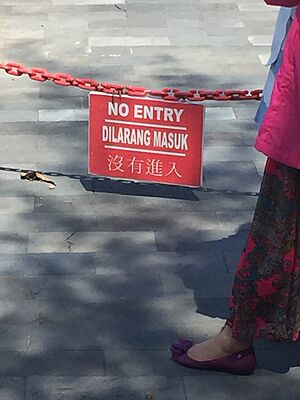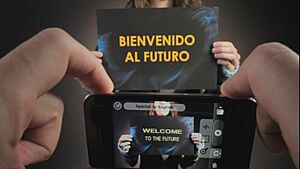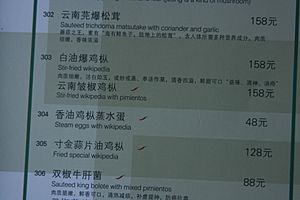Machine translation facts for kids
Machine translation is when computers use special programs to translate text or speech from one language to another. It tries to understand the meaning, common sayings, and even the feeling behind the words in both languages.
At first, these programs mostly followed strict rules or used statistics to translate. But now, newer methods like neural machine translation and large language models are much more common and powerful.
Contents
How Did Machine Translation Start?
Early Ideas: From Ancient Times to Computers
The idea of machine translation goes way back! An Arabic scholar named Al-Kindi in the 800s developed ways to understand and translate languages, using methods like looking at how often words appear. These ideas are still used today. Later, in the 1600s, René Descartes imagined a universal language where different languages would share the same symbols for ideas.
The idea of using computers for translation came up in 1947. Andrew Donald Booth in England and Warren Weaver in the U.S. both thought about it. Weaver's ideas in 1949 were very important for the early days of machine translation. In 1954, a computer at Birkbeck College even showed a basic translation from English to French!
Growing Up: The 1950s and 60s
The first researcher in this field, Yehoshua Bar-Hillel, started at MIT in 1951. Soon after, a team at Georgetown University showed off their translation system in 1954. Other countries like Japan and Russia also started their own research.
However, progress was slow. In 1966, a group called ALPAC (Automatic Language Processing Advisory Committee) looked at the research and said it hadn't met expectations. This led to less money for machine translation studies. But by the early 1970s, some systems, like Logos, showed success in translating military manuals.
Modern Era: From the 1970s to Today
In 1978, Xerox started using SYSTRAN to translate technical manuals. As computers became more powerful and cheaper in the late 1980s, people became more interested in using statistical methods.
The internet really changed things! SYSTRAN offered free online translation in 1996, and then AltaVista Babelfish became very popular, handling half a million requests a day by 1997.
In 2003, Franz Josef Och (who later led Google's translation efforts) won a big competition. More cool things happened, like MOSES (an open-source statistical translation program) in 2007, and mobile phone translation services. By 2012, Google Translate was translating enough text to fill 1 million books every single day!
How Does Machine Translation Work?
Before deep learning became popular, translation programs used many rules and needed lots of details about how words and sentences were built.
Rule-Based Translation
This older method used strict rules, like those found in dictionaries and grammar books. The biggest challenge was that everything had to be spelled out. For example, if a word could be spelled two ways, the program needed a rule for both. It also needed rules for every possible meaning of a word.
Transfer-Based Translation
This method tried to understand the meaning of the original sentence and then create a translation. It was partly based on the specific languages being translated.
Interlingual Translation
This was a special type of rule-based translation. The original text was first turned into a "language-neutral" form, like a universal code that didn't belong to any specific language. Then, the target language was created from this code. The KANT system, which translated Caterpillar Technical English, was one example.
Dictionary-Based Translation
This was the simplest method. Words were translated one by one, just like looking them up in a dictionary.
Statistical Translation
Statistical machine translation uses statistical methods to translate. It learns by looking at huge amounts of text that have already been translated by humans. For example, it might study records of the Canadian parliament (called Canadian Hansard) or the European Parliament (called EUROPARL) that are available in two languages.
If lots of these "parallel texts" were available, it worked well for similar types of writing. In 2005, Google improved its translation by using about 200 billion words from United Nations documents to train its system.
The main problem with statistical translation was that it needed massive amounts of parallel texts. It also struggled with languages that have many different word forms.
Neural Machine Translation
Neural machine translation (NMT) is a newer approach that uses deep learning, which is a type of artificial intelligence. It has made huge progress recently. Tools like DeepL Translator are very good, but even their translations often need a human to check and fix them.
Instead of training special translation programs, you can also ask large AI models like GPT to translate text directly. This is a promising new way, but it uses a lot of computer power.
Challenges in Machine Translation

Even the best machine translation tools can still make mistakes. Humans who check these translations often find problems.
Understanding Different Meanings
One big challenge is when a word has more than one meaning. For example, the word "bank" can mean the side of a river or a place where you keep money. A machine needs to figure out which meaning is correct based on the rest of the sentence.
Claude Piron, a translator for the United Nations, explained that machines can do the easy part of translation. But the hard part is when a sentence is unclear, and a human translator has to do a lot of research to figure out the true meaning. For example, "Japanese prisoners of war camp" could mean a camp where Japanese people were prisoners, or a Japanese camp holding prisoners from other countries. A machine might guess wrong, but a human would know to find out the correct meaning.
Informal Language
Machine translation struggles with informal language, slang, or unusual ways of speaking. It's usually trained on standard, formal language. This means it might make mistakes when translating casual conversations or text messages.
Names and Places
Translating names of people, organizations, or places (called "named entities") can be tricky. For example, "George Washington" should not be translated into another language; it should stay "George Washington." Machines sometimes translate them incorrectly as common words or leave them out entirely.
Sometimes, a machine needs to "transliterate" a name, which means finding the closest-sounding letters in the new language. For example, "Southern California" should have "Southern" translated, but "California" should be transliterated. Machines can get confused and try to transliterate both.
Where Is Machine Translation Used?
Even though no system is perfect, many automated systems produce good enough translations, especially when the topic is specific. This makes machine translation a helpful tool to speed up translations or get quick, low-cost translations.
Travel
Many apps on mobile phones and other devices use machine translation. These are great for travelers who need to understand signs, menus, or talk to people in other countries. For example, the Google Translate app can use your phone camera to translate text in real-time, showing the translated words right on your screen! It can also translate spoken words.
Government Work
Governments around the world use machine translation. The European Commission, for instance, uses it a lot to translate documents between the many languages of the European Union.
Wikipedia
Machine translation helps translate Wikipedia articles. There's even a "content translation tool" that makes it easier for editors to translate articles. This helps make more articles available in different languages, as the English Wikipedia often has more detailed articles than other languages.
Security and Military
After events like 9/11, countries like the U.S. became very interested in translating languages like Arabic, Pashto, and Dari. They use machine translation for quick communication between military members and civilians, often through mobile apps.
Social Media
With so many people using social media like Facebook and messaging apps like Skype, machine translation helps people who speak different languages talk to each other online.
Online Games
Some online games, like Lineage W, use machine translation so players from different countries can communicate during the game.
Medicine
Machine translation is being explored for use in hospitals and clinics, especially when human translators aren't available. However, doctors and researchers warn that mistakes in medical translations can be very dangerous. It's best to use machine translation in medicine only when there's no other choice, and a human should always check the translation for accuracy.
Law
Legal documents are very precise, which makes them hard for machine translation. Special programs have been made for legal texts. Still, experts recommend that human translators always review machine translations in legal cases because errors can have serious consequences. There are also concerns about privacy when lawyers use free online translation tools, as private information might be shared.
Ancient Languages
Thanks to new developments in AI, machine translation can now even help translate ancient languages like Akkadian (Babylonian and Assyrian), even when there isn't much existing translated text to learn from.
How Do We Know if Machine Translation Is Good?
There are many ways to check how well a machine translation system works. This depends on what the translation is for and how the software works.
The oldest way is to have human judges read the translations and decide if they are good. This takes a lot of time but is still the most reliable way to compare different systems. There are also automatic ways to score translations, like BLEU and METEOR, which compare the machine's translation to a human's translation.
It's important to remember that human language is complex and depends on the situation. Even human translators can make mistakes. So, to make sure a machine translation is truly useful and accurate enough to be published, a human should always review and edit it. As Claude Piron said, machines do the easy part; humans do the hard part of understanding the full meaning and fixing any unclear parts.
Sometimes, machine translations can be so bad that they are funny! There are videos online where people put Japanese characters into Google Translate, and the translations become completely silly, like "DECEARING EGG" or "Deep-sea squeeze trees."
Machine Translation and Sign Languages
In the early 2000s, it was hard to translate between spoken and signed languages. People thought deaf individuals could just use regular text translators, but signed languages have their own ways of showing stress, feelings, and timing that are very different from spoken languages.
Researchers developed a program called TEAM (translation from English to ASL by machine) to translate English into American Sign Language (ASL). The program would first understand the English text, then use a "sign synthesizer" (like a dictionary for ASL signs) to find the correct signs. Finally, a computer-generated person would appear on screen and sign the English text in ASL to the user.
Copyright and Machine Translation
Only original creative works can be protected by copyright. Some experts argue that machine translations aren't original because a machine made them, so they might not have copyright protection. However, the original author of the text still owns the copyright, and a translator (human or machine) needs permission to publish a translation of their work.
See also
 In Spanish: Traducción automática para niños
In Spanish: Traducción automática para niños
- AI-complete
- Comparison of machine translation applications
- Computational linguistics
- Computer-assisted translation
- Controlled natural language
- History of machine translation
- Human language technology
- Humour in translation
- Language barrier
- List of emerging technologies
- Mobile translation
- Neural machine translation
- Postediting
- Statistical machine translation
- Translation memory
- Universal translator



